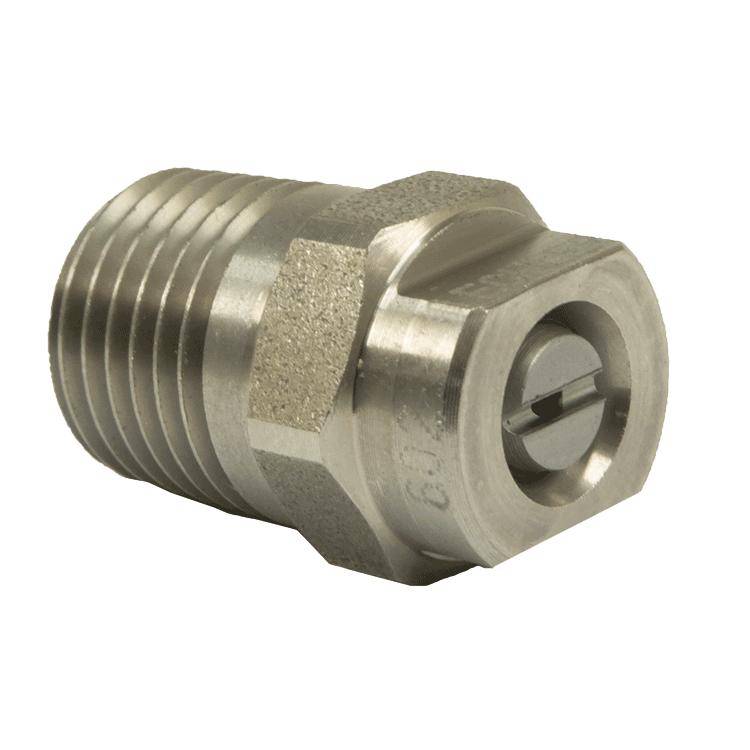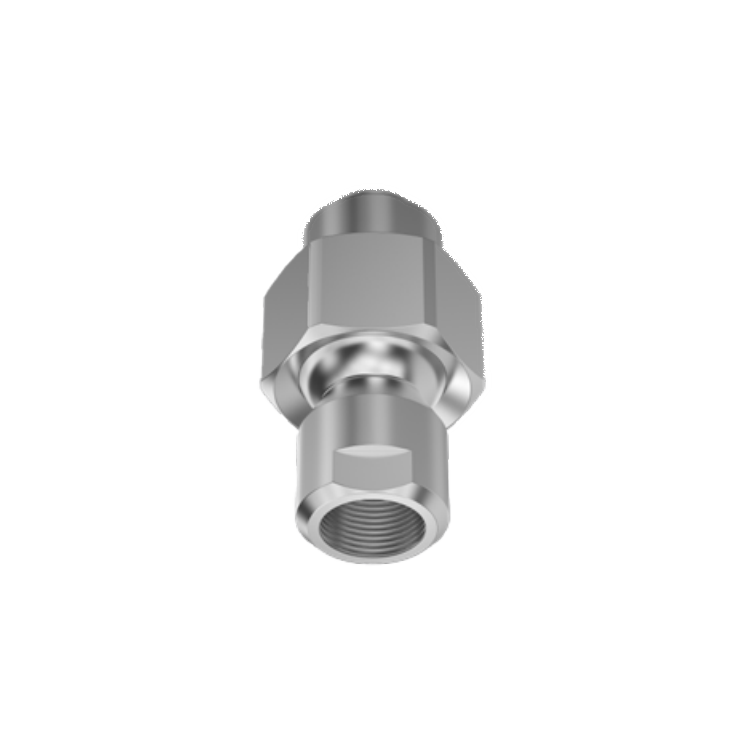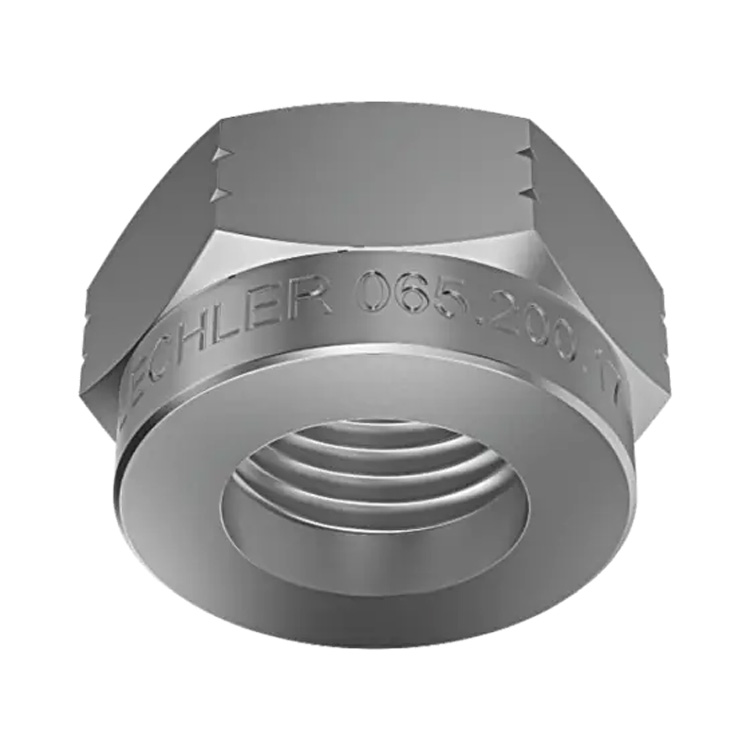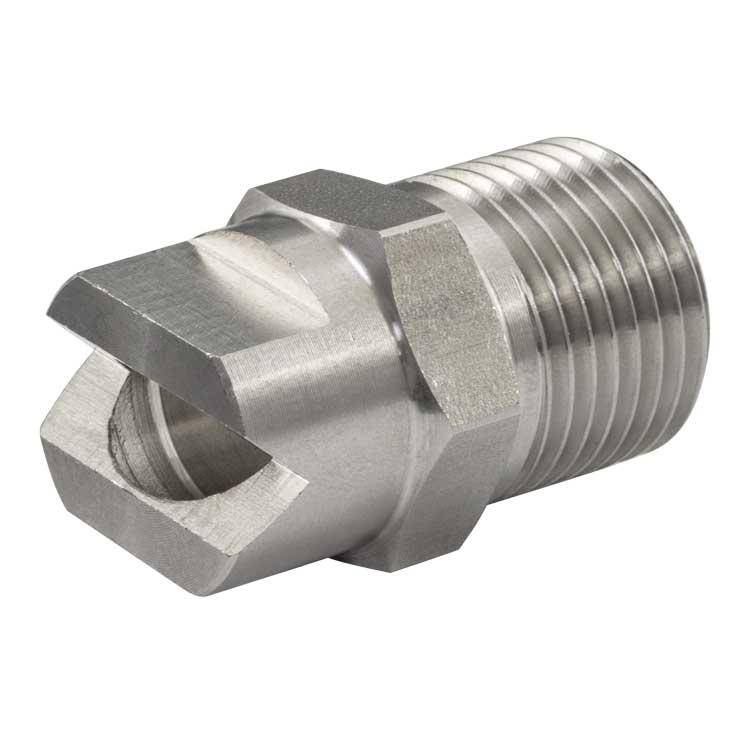Questions and answers
What types of nozzles are available?
Lechler Lechler offers a variety of nozzle types designed for different applications. The main types include:
- Flat fan nozzles: These nozzles produce a flat, fan-shaped spray jet and are often used in cleaning processes, surface technology and the steel industry.
- Full cone nozzles: They produce an even, circular spray jet and are suitable for washing and cleaning applications as well as chemical processes.
- Hollow cone nozzles: These nozzles produce an annular spray jet with fine droplets and are used for gas cooling, dust control and humidification.
- Solid jet nozzles: They deliver a concentrated, non-atomised jet and are used in cleaning processes, cutting operations and spot applications.
- Compressed air nozzles: These nozzles are designed for the targeted application of air or saturated steam and are used for drying, cooling, cleaning and conveying.
- Two-substance nozzles (pneumatic atomisers): They use a combination of liquid and gas to produce fine droplets and are used in cooling, disinfection, coating and spray drying.
- Container cleaning nozzles: These nozzles, both static and rotating, are designed for the internal cleaning of containers and tanks.
Auwatec offers a wide range of these Lechler nozzles, which are suitable for various industrial applications.
What happens if the nozzle is too large/small?
Choosing the right nozzle size is crucial for the efficiency and quality of spraying applications. Both too large and too small nozzles can have undesirable effects:
Nozzle too large:
- Overdosing: A larger nozzle allows more liquid to pass through, resulting in higher consumption and increasing costs.
- Uneven distribution: The droplets produced can be too large, resulting in uneven wetting of the target surface.
- Increased drift: Larger droplets are more prone to drift, especially in windy conditions, which affects the precision of the application.
Nozzle too small:
- Under-dispensing: A smaller nozzle delivers less liquid, which can result in insufficient coverage and effectiveness.
- Risk of clogging: Smaller orifices are more susceptible to clogging from particles or debris, resulting in downtime and increased maintenance.
- Increased pressure requirement: To achieve the desired flow rate, pressure must be increased, which increases energy consumption and can affect equipment life.
How do I clean Lechler nozzles properly?
Regular and proper cleaning of Lechler nozzles is crucial to ensure their optimal function and longevity. Here are the recommended steps for cleaning:
- Disassemble the nozzle:
- Switch off the system and relieve the pressure completely.
- Carefully remove the nozzle from the system.
- Rough cleaning:
- Rinse the nozzle with clear water to remove loose particles.
- Use a soft brush or cloth to remove visible deposits.
-
Fine cleaning:
- Soak the nozzle in a mild cleaning solution to loosen stubborn residues.
- Use suitable cleaning tools, such as special nozzle cleaning needles, to carefully clean the openings.
-
Rinse and dry:
- Rinse the nozzle thoroughly with clean water to remove all detergent residue.
- Allow the nozzle to air dry completely or dry it with a lint-free cloth.
-
Inspection and reassembly:
- Check the nozzle for damage or signs of wear.
- Refit the nozzle to the system and ensure that all connections are tight.
Notes:
- Avoid using sharp or metallic objects that could damage the nozzle.
- Observe the manufacturer's specific cleaning recommendations for the respective nozzle.
- Carry out regular cleaning intervals to ensure consistent spray quality.
- For detailed information and specific instructions on cleaning your Lechler nozzles, please visit the official website of Lechler or contact Auwatec customer service.
When should a nozzle be replaced?
Regular inspection and maintenance of Lechler nozzles is crucial to ensure optimum performance and efficiency. Nozzle replacement should be considered in the following cases:
- Signs of wear:
- Increased flow rate: An increase in flow rate may indicate wear on the nozzle, resulting in uneven distribution and increased material consumption.
- Altered spray pattern: Irregular or asymmetrical spray patterns indicate wear or damage.
- Physical damage:
- Cracks or breaks: Visible damage impairs function and can lead to safety risks.
- Corrosion: Material degradation due to chemical influences reduces the service life and efficiency of the nozzle.
- Blockages:
- Frequent blockages: Despite regular cleaning, recurring blockages may indicate internal damage or material fatigue.
- Ageing:
- Material fatigue: Over time, materials lose their original properties, which impairs performance.
To maximise the service life of your nozzles, Lechler recommends regular inspections and maintenance. Detailed information on nozzle maintenance and cleaning can be found on the official Lechler website.
For specific questions or to purchase replacement nozzles, please contact the Auwatec team.
How to choose the right Lechler nozzle for an application?
Selecting the right Lechler nozzle for a specific application requires consideration of several factors in order to achieve optimum results. The following steps will help you:
- Determine the application area:
- Cleaning: Flat spray nozzles that produce a uniform spray are suitable for high-pressure cleaning.
- Cooling or humidification: Hollow cone nozzles offer fine atomisation and are ideal for cooling and humidification processes.
- Coating Full cone nozzles are often used for uniform coatings.
- Determine spray angle and shape:
- The desired spray angle influences the coverage and intensity of the spray jet. Lechler offers nozzles with variable spray angles, for example from 15° to 65° for high-pressure flat spray nozzles.
- Take the flow rate and operating pressure into account:
- The nozzle size determines the flow rate at a given pressure. It is important to select the nozzle to match the requirements of the system to ensure efficient performance.
- Check material and chemical resistance:
- The nozzle material should be selected depending on the medium used and the ambient conditions. Lechler offers nozzles made of different materials such as stainless steel and ceramic, which are suitable for different applications.
- Observe special requirements:
- Special nozzles are required for applications with abrasive media or high temperatures. Ceramic high-pressure nozzles from Lechler, for example, offer a longer service life in abrasive applications.
For a precise selection, it is advisable to consult the technical data and specifications of the respective nozzle. Auwatec offers a wide range of Lechler nozzles and will be happy to assist you in selecting the right nozzle for your application.






